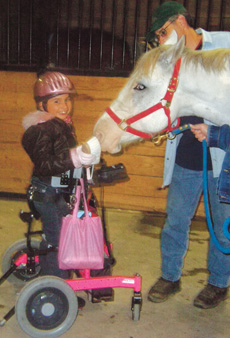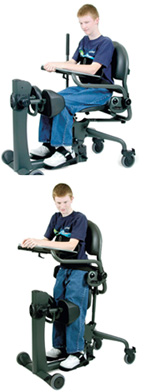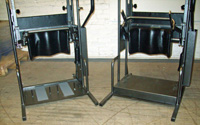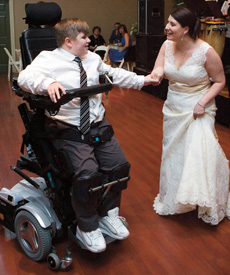
Stand Up!

The benefits of standers for children are clear.
Ten-year-old Morgan Fritz of St. Peters, Mo., received a spinal muscular atrophy (SMA) diagnosis when she was 15 months old. Three months later, she began a standing program, and she’s kept at it ever since.
Instead of a wheelchair, Morgan, who was the 2005 MDA National Goodwill Ambassador, uses a Standing Dani Dynamic wheel stand from DavisMade as her main form of mobility. She typically stands for four to five hours per day, as recommended by her physical therapist (PT).
Although there’s no scientific proof, her parents, Ron and Sue Fritz, believe Morgan’s standing routine over the years is a big reason why she doesn’t show any signs of scoliosis (curvature of the spine) today.
Whether or not standers actually slow the development of scoliosis, the devices do provide a host of other benefits for children with neuromuscular diseases.
 Children who aren’t walking, or who have mostly lost their ability to walk, should start a standing program sooner rather than later, experts recommend.
Children who aren’t walking, or who have mostly lost their ability to walk, should start a standing program sooner rather than later, experts recommend.
But standing is not as simple as it sounds. There are a variety of things parents should consider when deciding on the right stander for their child.
When to stand?
There’s no set age for when children should start standing, says Mary Fournier, a PT who works with the MDA Clinic at Rhode Island Hospital in Providence. She also is the clinical supervisor for the hospital’s early intervention program.
Standing is very individualized and depends on the diagnosis, disease onset and level of ability.
Most children who receive a neuromuscular disease diagnosis within the first few months of life can start standing at around a year, says Fournier.
Older children who have never stood, or who haven’t stood in more than five years, need a bone-density test to ensure their bones are strong enough to tolerate standing, or a bone fracture can occur, says Lauren Rosen, a PT and assistive technology practitioner (ATP) who works with the MDA Clinic at St. Joseph’s Children’s Hospital in Tampa.
If children still are walking most of the time and only using a wheelchair occasionally, they’re not yet ready for a stander, says Rosen, adding, “If I have a kid who can still move, I’m not strapping them down!”
But it’s a different story for children who are doing extremely limited amounts of walking and weight bearing, and who are sitting in a wheelchair most of the time.
“Even though they’re still able to walk — which is great, and they need to keep doing that — they also need to have some symmetrical weight-bearing therapeutic standing,” says Amy Meyer, Permobil’s pediatric and standing specialist, who is a PT and ATP.
Health benefits
 Because the human body is designed to be vertical, its internal systems function more naturally when the person is standing. Being upright allows gravity to help empty the bladder more completely, reducing urinary tract infections. Standing also helps with digestion, elimination, respiration and circulation. Removing pressure from the rear end allows for unobstructed blood flow, helping to prevent painful pressure ulcers.
Because the human body is designed to be vertical, its internal systems function more naturally when the person is standing. Being upright allows gravity to help empty the bladder more completely, reducing urinary tract infections. Standing also helps with digestion, elimination, respiration and circulation. Removing pressure from the rear end allows for unobstructed blood flow, helping to prevent painful pressure ulcers.
Sitting all the time puts kids at risk for developing contractures (stiffened joints and associated tissues due to weakened muscles). Supported standing straightens joints, improves range of motion and flexibility and helps to prevent ankles, knees and hips from developing contractures in a flexed position, experts say.
In addition, when children don’t bear weight on their legs, their bone density decreases, “and it decreases pretty quickly,” says Meyer. “The earlier you initiate a standing program, the less you’ve lost.”
[Note: While it’s been proved that standing helps maintain bone density, studies are inconclusive as to whether or not it improves bone density. “A lot of research is happening in that area,” says Fournier.]
Although there’s no proof that standing in a stander can prevent or slow the development of scoliosis, it does promote better posture, says Fournier.
Medical professionals have differing opinions as to how long people should stand in standers each day to get these health benefits.
Rosen, who works with both children and adults in the MDA clinic, advises standing for two hours each day. “Not necessarily two hours at one time,” she says. “They can do 30 minutes here, 30 minutes there, but I tell them that I’d like them to shoot for two hours every day.”
Other experts say that standing for 45 minutes every day offers some benefits as well. Parents should ask their child’s PT how long their youngster should stand.
Morgan spreads out her standing time by sitting and standing throughout the day, says her mother. Her Standing Dani has a removable “bicycle-type” seat that allows her to rest from time to time.
Whatever the time frame, make sure using the stander is a positive experience for children so they want to do their standing time. Some children like to play video games, watch movies or play with toys while they stand; others like to do their homework or eat dinner while standing.
The perfect fit
Parents wouldn’t buy their children shoes that don’t fit, says Fournier. Why should buying a stander be any different? “I always recommend that a child be evaluated by a physical therapist before being placed in a stander,” she says.
 A PT can help select the most appropriate type of stander, and the assistive technology supplier at the durable medical equipment dealer will make adjustments and order extra supports so the child is standing properly. Poorly fitting standers can cause pain, discomfort and even long-term damage, says Fournier.
A PT can help select the most appropriate type of stander, and the assistive technology supplier at the durable medical equipment dealer will make adjustments and order extra supports so the child is standing properly. Poorly fitting standers can cause pain, discomfort and even long-term damage, says Fournier.
Most child/youth standers adjust with the growing child and usually last at least three years. Once the child has outgrown the stander, it should be replaced for safety reasons.
Larger and taller children sometimes use adult standers. If they’re large enough but not quite tall enough for an adult model, some modifications are possible. For example, the Elevated Floor from Stand Aid of Iowa ($100) fits on any of the company’s adult standers, adding up to 4 inches of height for short adults and large children.
Types of standers
In general, standers for children come in three positions: upright or vertical (the user stands up straight), supine (the user tilts backward) and prone (user tilts forward).
Standers can be stationary (not meant to be moved while in use) or mobile/dynamic (they can be driven or propelled by the user while being used). See “Standing on the Go” for more on mobile standers.
Most stationary standers have small casters for easy transport from room to room, but it’s never advisable to move a stationary stander while the child is standing in it.
Sit-to-stand standers
A sit-to-stand stander raises the child from sitting to standing using either a manual hydraulic pump or a power lift.
Sometimes the terms “sit-to-stand” and “upright” stander are used interchangeably, because almost all upright standers have this feature, while supine and prone standers generally do not.
Sit-to-stand makes standers easier to use. Although very young children can be fairly easily put into any type of stander, it’s more difficult to position older or heavier children without this feature.
Because most sit-to-stands put the user in an upright position, they’re not appropriate for all children, warns Trent McCallson of Western Assistive Technology Consulting in Las Vegas. These standers require some trunk control and good head control, because many of them don’t provide head support.
To stand in a fully upright position, a child must have enough bone density to tolerate total weight bearing. If his or her bones aren’t strong enough, a sit-to-stand stander sometimes can be used so it’s not 100 percent raised up, and the child isn’t fully standing, says Rosen.
With some sit-to-stand standers, the child is manually transferred from the wheelchair into the seat of the stander, which then gradually stands the child while supporting the back.
Other sit-to-stands don’t require a transfer, which is helpful for parents. A child can go directly from the wheelchair to standing by having a strap placed under his or her buttocks and hooked to the stander.
The EasyStand Evolv Youth from Altimate Medical ($2,695) is designed for older children, teenagers and smaller adults under 5 feet tall. Features include a rotating seat for easier transfers and an active standing glider feature that allows the upper body to move the lower body. In addition, it offers the option of switching from a stationary to mobile stander.
Adjustable to accommodate a growing teenager, the Evolv Youth comes with a choice of a manual or power lift and can be converted into an adult stander by purchasing a growth kit ($600).
Supine and prone standers
If, for the reasons mentioned above, a child can’t tolerate being fully upright, the PT may suggest using a supine or prone stander, says McCallson. These standers offer most of the benefits of upright positioning, but the amount of weight bearing is less, depending on how much the child is tilted.
A prone stander leans children forward at varying angles, depending on their tolerance for weight bearing, and supine standers lean them backward at varying angles.
Prone standers require good head control and neck strength, while supine standers are best for children with little to no head control, says Rosen.
Because most prone and supine standers don’t have the sit-to-stand feature, children have to be lifted in manually, making them most suitable for very young or very small children.
However, Altimate Medical now offers the EasyStand Bantam ($2,095), a supine stander with a spring-assisted lift to take a child from sitting to standing. With the Bantam, the child is laterally transferred into the seat of the stander, making it easier and safer for both parent and child.
The Rifton Prone Stander (Rifton Equipment, $1,320 to $1,755), is available in three sizes for users ranging from 2-feet-1-inch to 6 feet. These standers offer manual adjustment of the angle at which the child is leaning forward, and adjustable supports for alignment of the trunk and lower extremities.
Many standers, such as Prime Engineering’s Superstand ($2,495-$3,195), offer the capability to be either prone, supine or upright. Although these frames can go fully upright, they don’t offer the sit-to-stand feature.
The Superstand can be customized for the child’s growth, and adjustments can be made without tools. It fits children from 2-feet-2-inches to 4-feet tall, and also comes in a youth model for larger children.
Standing on the go
Parents want their children to gain all the health benefits of standing, but children want to be on the move all the time.
One solution is to get a mobile (dynamic) stander. These standers, which come in either manual or power models, allow children to drive around while standing.
Former MDA National Goodwill Ambassador Morgan Fritz, 10, of St. Peters, Mo., can keep up with the other fourth-graders at Warren Elementary thanks to her mobile Standing Dani, (DavisMade, $9,000-$17,000), which she controls with a joystick.
The mobile stander enables Morgan to do such things as join other kids at recess to play soccer and four-square. When she goes to therapeutic riding once a week, she brushes her horse, Mouse, from a standing position.
The Standing Dani also gives Morgan a greater sense of responsibility and a can-do attitude by allowing her to get the mail, help out around the house and do more things independently.
“I can do some of my chores in the house,” she says. “I can wash the table, and sometimes I’ll try and clean some of the higher stuff that I can reach.”
Sue Fritz, Morgan’s mom, says kids think the Standing Dani is “cool,” which makes Morgan feel better about needing it.
“Plus she’s on the same level as the kids when she’s standing,” says Sue. “Nobody’s looking down at her, so her confidence level is up too.”
For children who are able to push themselves in a manual wheelchair, Snug Seat offers the Rabbit dynamic stander ($1,875-$2,775), a manually propelled mobile stander that can be used from an upright position. With a choice of four sizes, the Rabbit fits children and teens ages 1 to 18. Children can propel the Rabbit even when it’s at an angle.
Standing wheelchairs
Sometimes mobile standers don’t offer enough independence.
“If you have a reason to stand up throughout your day, multiple times, then a standing wheelchair may be the better option, because it allows you to do it easily [without help],” says Lauren Rosen, physical therapist (PT) at St. Joseph’s Children’s Hospital in Tampa.
 Standing wheelchairs can be power or manual, and the stand-up function also can be power or manual.
Standing wheelchairs can be power or manual, and the stand-up function also can be power or manual.
Eleven-year-old Jacob Richard of Sugar Land, Texas, recently received Permobil’s latest standing power wheelchair, the C500 VS ($11,785-$12,995). Jacob, who received a diagnosis of Duchenne muscular dystrophy at age 4 and stopped walking at age 10, loves having the ability to stand whenever he wants.
Jacob uses his wheelchair as a supine stander, leaning backward from 10 to 20 degrees because he’s not yet comfortable standing all the way upright. His mother, Stephanie, says that Jacob will work with his PT until eventually he gets comfortable in a completely upright position.
Even though Permobil offers a pediatric version of the chair (the C400 VS JR; $9,995) Jacob fit better in the adult version and has room to grow.
The new power seat memory functions of the C500 VS make it easy to get into the desired standing position, further increasing Jacob’s independence.
Jacob simply pushes a button and the chair takes him through his preferred standing process. In the older version, he would have had to push a sequence of buttons to stand.
As a fifth-grader at St. Lawrence Catholic School, Jacob uses the standing feature to reach books in his locker, write on the chalkboard and be eye-level with his peers.
“I really like that because it’s good for me and it makes things a little bit easier,” Jacob says. “Like I can dance with people easier.”
After practicing for a few months, Jacob put his dancing skills to the test at his cousin’s wedding, where he danced with the bride.
Paying for your stander
Children’s physical capabilities and needs aren’t the only factors that determine which type of stander is appropriate. The decision also is based on expense and funding resources.
A basic stationary stander usually will be funded by private insurance providers and state Medicaid programs. A detailed note from the child’s physician or therapist is required, stating the child’s specific medical needs, not just a list of the health benefits of standing.
Typical reasons for denial include: lack of evidence cited in the documentation; not listing alternative devices that were considered; and the specific policy doesn’t cover standers.
“It’s all in how you present it,” says Trent McCallson, an assistive technology supplier with Western Assistive Technology Consulting, Las Vegas. He notes that insurance companies are well aware of how much it costs when a patient is hospitalized with complications that could have been prevented by a standing routine. “Success in getting [standers] funded relies on the ability to communicate with an insurance company where the benefits really are,” he says.
Some private insurance providers cover mobile standers, and in some states, Medicaid will cover them, but be prepared to explain why mobility is crucial to the child’s well-being.
When private insurance providers cover basic stationary standers but not mobile standers, sometimes they’ll consider a partial payment. The insurer will cover the basic stander price, and the consumer will pay the difference in price for a mobile device.
Some private insurance providers and Medicaid programs will cover standing wheelchairs, but it’s typically not easy to get coverage, sometimes requiring multiple appeals and quite possibly a hearing, says Amy Meyer, Permobil’s pediatric and standing specialist. Sometimes Medicare will cover standing wheelchairs, but the process can be even more difficult.
The clinic team must prove why a standing wheelchair is needed over a basic stander. Both offer medical benefits, but standing wheelchairs allow for independent standing throughout the day, providing the benefit of more frequent standing. Standing wheelchairs also require fewer transfers, providing energy conservation and reducing the risks of injury. Standing wheelchairs also offer the child more function and independence with accessing the environment and completing activities of daily living.
It’s important to show that the cost of a standing wheelchair is very comparable with — and sometimes even less than — the cost of a complex power wheelchair and a separate sit-to-stand stander, experts say.
Meyer notes that in some cases, private insurance providers who don’t cover standing wheelchairs have covered the cost of the wheelchair base and necessary power seat functions, and parents have purchased any noncovered items.
Of course, don’t forget to check the MDA website to see what standing equipment may be available for loan.
Another option is to buy a used stander from the DME dealer, but don’t forget to get the stander fitted to the child. Be wary of buying a stander off the Internet, because there’s no expert to ensure it fits properly.
In addition, each state has a federally funded Assistive Technology (AT) Act program that helps improve access to AT products and services.
MDA Resource Center: We’re Here For You
Our trained specialists are here to provide one-on-one support for every part of your journey. Send a message below or call us at 1-833-ASK-MDA1 (1-833-275-6321). If you live outside the U.S., we may be able to connect you to muscular dystrophy groups in your area, but MDA programs are only available in the U.S.
Request Information